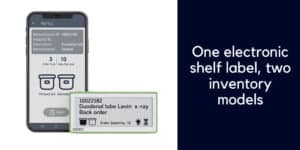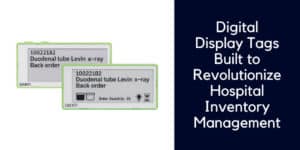What’s inside:
Achieving greater medical inventory supply chain resilience has become a top priority for many rural hospitals. This article looks at:
- How community hospitals can gain better control of their medical inventory
- The role of technology in streamlining workflows and improving supply chain efficiency
- Tackling the high cost and wastage of medical devices, implants and other surgical supplies
- The business case for hospital supply chain automation tools
Community healthcare providers make up 35% of US hospitals and serve 46 million Americans according to a recent New York Times article about the challenges faced by rural hospitals.
Rural healthcare provides the public with dedicated care in a convenient setting, but local healthcare cannot be taken for granted – an increasing number of rural hospitals are facing financial struggles, and between 2010 and 2021, a shocking 136 US community hospitals closed down.
If strong, well-funded healthcare systems suffered during the pandemic, and are still doing so in the aftermath, then rural healthcare providers are naturally under even greater pressure.
So, as the dust settles on the chaos caused by COVID19, what action can community hospitals take to improve their operating margins and strengthen their performance?
Rural hospital supply chain challenges
Typically, medical inventory and supplies eat up around 25% of US hospital budgets, and smaller community hospitals, with less buying power, will be weighed down by even higher costs.
According to a 2018 clinical journal article, hospitals spent approximately $200 billion on medical devices alone. Since medical devices, implants and other surgical supplies are collectively one of the biggest areas of healthcare expenditure, it’s crucial that rural hospitals and surgery centers have strong management and control of their medical inventory.
Many larger, urban healthcare organizations have systems in place to ensure accurate implant tracking, careful stock monitoring, cost control measures and revenue optimization. Unfortunately, their rural counterparts often rely on manual systems or old technology and the consequence is a bloated inventory, high costs, high wastage and missed surgical revenue.
Rural healthcare providers can reverse this picture by implementing automated inventory management solutions that improve the flow of data across the supply chain.
Using medical surgical supply chain data to improve efficiency
Data is what makes the modern hospital work smarter.
When accurate data flows from clinical areas into operational and financial departments via integrated hospital systems – there is a synergy across the organization, a shared understanding of the care provided, the inventory used, the items to bill.
But when there are siloed workflows, disparate systems, dated tools and inefficient perioperative software for data capture, it’s a very different picture.
The manual systems and outdated technology that is prevalent in rural hospitals obscures inventory visibility and hampers supply chain management. Incomplete and inaccurate data has an impact across the supply chain, and often prompts labor-intensive activity.
Lack of product integrity
Many hospitals manually check their stock to identify and remove any expired items, as well as to rotate stock so that soonest-to-expire items are used first.
Inefficient manual expiry control commonly results in expired or expiring items being missed and remaining on the shelves, leading to several issues:
- Risk of accidental usage – consumption of expired products in surgery is a huge patient safety risk.
- Wasted products – expired batches of high-value medical devices can expire on the shelf – which is an expensive and preventable error.
- Wasted time – busy staff can take many hours or even a few days a month, to manually check and monitor the inventory at hand.
Expiry management is a patient safety issue and requires a robust, automated inventory management solution that supports maximum patient protection.
Procurement based on partial vision
As we have already mentioned, the cost of healthcare inventory is one of the highest areas of expenditure for a hospital. Restocking supplies and medical inventory requires a clear vision of the stock at hand, as well as accurate utilization figures. Inaccurate hospital supply chain data is the bane of Materials Managers’ lives and leads to procurement errors.
As an article by the Community Hospital Corporation states: “You need to be sure that your materials department is ordering the right volume of materials in order to sync up with the volume used by your staff, and that there is no excess material being ordered on the basis of someone’s gut instinct, and all of this should happen without jeopardizing the safety of your patients.”
‘Best guess’ procurement leads to the over-ordering of many items. As Materials Managers endeavor to prevent stockouts, they err on the side of caution, resulting in the opposite phenomenon, surplus stock.
As the CHC article comments, “If you’re carrying excess inventory in your organization, that amounts to unused and dead revenue. “
In fact, surplus stock does not just waste the procurement budget, it often results in a second financial blow too, as over-stocked items often end up expiring on the shelves.
Best practice is to place restock orders based on usage volumes and to minimize inventory levels. Carrying excess inventory clutters up storage spaces, makes stock control challenging and risks high levels of product obsolescence.
So how can rural hospitals improve their healthcare inventory management?
It all comes back to data.
Lack of inventory visibility and incomplete usage data causes chaos in the management of inventory and costs healthcare providers dearly.
There are two critical points in rural healthcare supply chain management that are crying out for improved technology – and these are areas managed by clinical staff, not materials management. The two priority areas are:
- Systems that deliver real-time medical inventory visibility in the surgical setting
- Tools that record full and accurate utilization at the point of care

The business case for supply chain automation tools
Rural and community hospitals often lack the resources to upgrade their systems, with many still using manual processes for tasks where automated solutions are available.
Even where rural healthcare providers have a degree of automation, outdated point of use systems and older technology often lacks adequate data integration with hospital systems.
Purchasing healthcare automation solutions on an already stretched budget is difficult and yet, if you look at the cost of not upgrading, then the business case is clear.
| Expense category | Cost of not upgrading | Health Tech Solution |
| Staffing costs | ‑ Hours of lost nursing time spent hunting down PPI and surgical supplies ‑ Hours of inventory rounds by logistics staff attempting to monitor stock levels ‑ Wasted time at the point of care by busy nurses who struggle to record all relevant data on the items used in surgery ‑ Cost of case documentation audits set up to ‘catch’ any missing or incorrect inventory. | – An automated system that provides full, real-time stock visibility
– A point of use data capture tool that easily documents every billable item consumed |
| Inventory costs | ‑ Bloated inventories based on ‘best guess’ procurement. ‑ Unnecessary expenditure on medical inventory and supplies ‑ Surpluses and stockouts ‑ Expensive last-minute orders to compensate for out-of-stock items. | ‑ Item tracking to highlight the stock at hand as well as usage. ‑ System reports and data analytics that support lean inventory management |
| Wastage costs | – High expiry waste – ‘Zero’ items that continue to be ordered but are no longer used by the clinical team.
| – System Reports that minimize wastage such as:
|
| Patient safety | – Inaccurate surgical charting puts patients at risk and could result in expensive legal costs – Recall management is time consuming without accurate, digital records. – Organizational and staff non-compliance with FDA UDI regulations | – Full and accurate medical charting at the point of care – Digital record of all medical devices and implants used in surgery, as required by FDA UDI regulations |

Achieving supply chain resilience and efficiency
Many community hospitals are operating with negative margins, and this is prompting them to look at the medical inventory supply chain as a priority area in their cost reduction initiatives.
Technology can play a key role in lowering costs, reducing admin, tackling wastage and improving revenue capture.
One of the benefits of introducing efficient technology is reduced labor – and with materials management and nursing staff shortages particularly common in the rural setting, freeing up staff from cumbersome admin processes is a key driver for change too.
It can be difficult to identify the right medical inventory automation solution, but some key features to look out for are:
- ease of use for clinicians
- complete and accurate data capture
- full inventory visibility
- data reports, metrics and analytics
- interoperability with hospital systems
Enlightened rural hospital leadership is increasingly reaching for a digital lifeline, to add efficiency and resilience to the medical inventory supply chain. They are finding that new supply chain automation tools powered by RFID, image recognition, AI and ML technologies are achieving reduced costs, reduced wastage and increased revenue – a good return on investment.
Contact us to find out how smart technology is digitizing the rural hospital supply chain.






